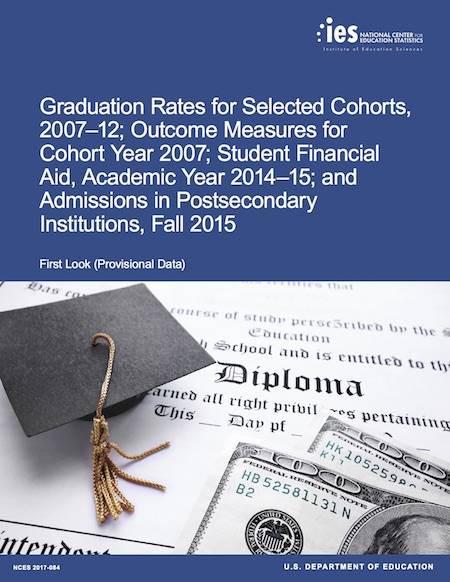 A new report from the U.S. Department of Education offers data on the racial gap in college graduation rates at different types of educational institutions.
A new report from the U.S. Department of Education offers data on the racial gap in college graduation rates at different types of educational institutions.
If we look at all four-year educational institutions, we find that 39.5 percent of African Americans who entered these institutions in 2009 seeking a bachelor’s degree earned their degree within six years. For Whites seeking bachelor’s degrees, the graduation rate was 59.4 percent. At private, not-for-profit colleges and universities, the racial gap was even more pronounced. At these four-year institutions, the Black graduate rate was 43.5 percent, more than 26 percentage points below the rate for White students.
For African Americans, there was a significant gender gap in college graduation rates favoring women. The graduation rate for Black women was nearly nine percentage points higher than for Black men.
When we look at data for two-year colleges, we find a much smaller racial gap. The data shows that 24.7 percent of African Americans who enrolled in associate’s degree programs in 2012 earned their degree within three years. For Whites seeking associate’s degrees, the graduation rate was 33.2 percent.
Here, too, there was a significant gender gap among African American students. Some 27.2 percent of Black women who enrolled at a two-year college in 2012 earned their associate’s degree by 2015. For Black men, the graduation rate at two-year colleges was 21.4 percent.
Undoubtedly, economic factors, including lower family income and wealth among African Americans and insufficient financial aid, were major contributors to the large racial gap in college graduation rates.
The full report, Graduation Rates for Selected Cohorts, 2007–12; Outcome Measures for Cohort Year 2007; Student Financial Aid, Academic Year 2014–15; and Admissions in Postsecondary Institutions, Fall 2015, may be downloaded by clicking here.












It will be more helpful to discuss solutions and real examples of those solutions in action than continuously focusing on the problem.
focusing and continuing on the issue and its origin does better than not acknowledging the problem and siloing to solutions
Things change over time not over night as a fact. Economical change, no matter the Race, moves the slowest of all. According to a recent study….
Over the past 25 years, the total enrollment of adults in degree-granting institutions increased for Whites, Blacks, and Hispanics.
Undergraduate enrollment figures include all students, regardless of age, enrolled either part time or full time in undergraduate studies at a degree-granting institution.
Between 1976 and 2008, total undergraduate fall enrollment increased for each racial/ethnic group.
Asian/Pacific Islander enrollment increased six-fold, from 169,000 in 1976 to 1,118,000 in 2008. Hispanic enrollment rose from 353,000 in 1976 to 2,103,000 in 2008—approximately six times the enrollment in 1976.
These two racial/ethnic groups had the fastest rates of enrollment growth, leading to increases in their share of total enrollment between 1976 and 2008: from 2 to 7 percent for Asians/Pacific Islanders and from 4 to 13 percent for Hispanics.
During that time period, American Indian/Alaska Native enrollment more than doubled, increasing from 70,000 to 176,000.
Black enrollment rose from 943,000 to 2,269,000, increasing their share of overall enrollment from 10 to 14 percent.
White enrollment also increased, but at the slowest rate of all racial/ethnic groups. Although White enrollment rose from 7,740,000 to 10,339,000,
White enrollment as a percentage of total enrollment declined from 82 percent in 1976 to 63 percent in 2008.
In other words, As Black Americans we’re moving forward, especially educationally, not backwards. But If we as a people continue to listen to Whites always negative genre and accepting it as Gospel, we’ll be moving backwards soon!!
They just graduate more, because there are more.
In another addition of this journal maybe 5 years ago an article outlined the achievement gap, between differing races. At high school graduation Whites and Asian students averaged a 12.3 yr level, Black students 9.3 yr level and Hispanics 9.5 yr level.
The LA Times has had several pieces detailing the SAT adjustments by race
Black students +200 points
Hispanic. +150
Asian. -50
White. No adjustments
I’m looking at those two sets of numbers wondering if we aren’t setting some Black and Hispanic students up for failure. Students representing those two groups leave high school behind Asian and White students. Taking their SAT the scores are boosted by 150-200 points which is significant.
Starting the path to winning their degree students regardless of race or color are on the same
level, they all compete for grades on a level playing field. At this point is it not likely that the Black and Hispanic kids might struggle compared with Asian students in particular?
Note- I’m regurgitating the numbers from memory I could be slightly off.